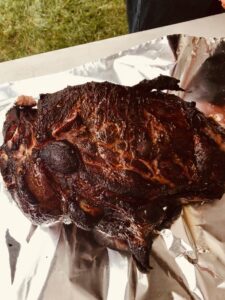 Are you looking for the perfect BBQ dish to impress your friends and family? How about a low-cost high-volume meal to feed the masses? Look no further than smoked pulled pork! This delicious and flavorful meal is easy to make and is always a crowd-pleaser. In this blog, we’ll walk you through everything you need to know to smoke the perfect pulled pork, from choosing the right cut of meat to selecting the best wood chips for flavor. So fire up your grill or smoker and get ready to blow your friends minds with the best pulled pork they’ve ever tasted!
Are you looking for the perfect BBQ dish to impress your friends and family? How about a low-cost high-volume meal to feed the masses? Look no further than smoked pulled pork! This delicious and flavorful meal is easy to make and is always a crowd-pleaser. In this blog, we’ll walk you through everything you need to know to smoke the perfect pulled pork, from choosing the right cut of meat to selecting the best wood chips for flavor. So fire up your grill or smoker and get ready to blow your friends minds with the best pulled pork they’ve ever tasted!
Origins of Smoked Pulled Pork
The process of smoking meat has b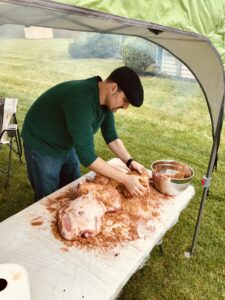 een around for centuries. It is widely believed that the origins of pulled pork can be traced back to the southeastern United States, particularly in the Carolinas. In these states, pig farming was a common practice and pork was a staple of the diet. As a result, people began to develop methods for preserving and cooking pork that involved smoking it over wood fires. One of these methods involved slow-smoking a pork shoulder or pork butt until it was tender enough to pull apart, and pulled pork was born!
een around for centuries. It is widely believed that the origins of pulled pork can be traced back to the southeastern United States, particularly in the Carolinas. In these states, pig farming was a common practice and pork was a staple of the diet. As a result, people began to develop methods for preserving and cooking pork that involved smoking it over wood fires. One of these methods involved slow-smoking a pork shoulder or pork butt until it was tender enough to pull apart, and pulled pork was born!
Over time, pulled pork became a popular dish at BBQ joints and backyard cookouts throughout the southeastern United States. It eventually spread to other parts of the country, and today it is enjoyed by BBQ lovers all over the world.
How to Smoke Pulled Pork Like a Pro
 While the specific methods for smoking pulled pork have evolved over the years, the basic principles remain the same: slow-smoking a pork shoulder or butt over low heat until it is tender and flavorful. Whether you’re using a wood-fired pit, charcoal grill, pellet grill, a propane smoker, or an electric smoker, the goal is always the same: to create delicious, succulent, and perfectly tender pulled pork.
While the specific methods for smoking pulled pork have evolved over the years, the basic principles remain the same: slow-smoking a pork shoulder or butt over low heat until it is tender and flavorful. Whether you’re using a wood-fired pit, charcoal grill, pellet grill, a propane smoker, or an electric smoker, the goal is always the same: to create delicious, succulent, and perfectly tender pulled pork.
First, let’s start with the basics. Pulled pork is a type of BBQ dish that’s made by slow-smoking a pork shoulder or pork butt (which is actually the same cut, just from a different part of the pig) until it’s tender enough to easily pull apart with a fork. The result is a juicy, flavorful, and incredibly tender pork that’s perfect for sandwiches, tacos, or any other dish you can dream up.
Selecting Pork Butt or Shoulder
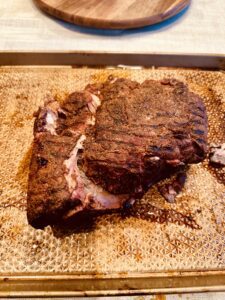 The best cut of meat for pulled pork is typically a pork shoulder, also known as a Boston butt or pork butt. This cut has a good amount of marbling and fat, which helps to keep the meat moist and flavorful during the long cooking process. Look for a cut that has a nice balance of fat and meat and has a deep pink color. Bone-in cuts are preferred as the bone can help to add additional flavor to the meat.
The best cut of meat for pulled pork is typically a pork shoulder, also known as a Boston butt or pork butt. This cut has a good amount of marbling and fat, which helps to keep the meat moist and flavorful during the long cooking process. Look for a cut that has a nice balance of fat and meat and has a deep pink color. Bone-in cuts are preferred as the bone can help to add additional flavor to the meat.
A picnic shoulder is a cut of pork that comes from the lower part of the shoulder. It is similar to a Boston butt or pork butt, but it is a bit larger and has a bit more fat. This cut of meat is often used for slow-cooking methods such as smoking or braising, and it is a popular choice for pulled pork because it has a good balance of fat and meat and is less expensive than a shoulder.
In addition to the pork shoulder (Boston butt or pork butt) and picnic shoulder, other cuts of pork that can be used for pulled pork include:
- Pork loin: A leaner cut of meat that has less fat and marbling than the pork shoulder, but it can still be used for pulled pork if it is cooked low and slow, and with added moisture.
- Pork belly: This cut is very fatty and is often used to make bacon, but it can also be used for pulled pork if it is cooked low and slow and the fat is rendered out.
- Pork jowl: Similar to pork belly, it is a fatty cut that can be used for pulled pork if cooked low and slow and the fat is rendered out.
It is important to note that while these cuts can be used for pulled pork, they may not have the same flavor or texture as the pork shoulder, which is the traditional cut used. Pork shoulder tends to have a good balance of fat and meat, which keeps the meat moist and flavorful during the long cooking process.
Now, on to the smoking process. Here's what you'll need:
- A pork shoulder or pork butt
- A dry rub or BBQ sauce (or both!)
- A smoker (electric, propane, wood-fired, or even a charcoal grill will work)
- Wood chips or chunks (depending on your smoker)
- A meat thermometer
- Aluminum foil
Step 1: Prep the meat, mix the rub, and cook up your sauces
The first step in smoking pulled pork is to prep the meat. This involves trimming any excess fat (anything more than ¼” thick) or hanging pieces (they won’t survive the long cook) and applying salt.
- Wet the pork and sprinkle about a tablespoon of kosher salt evenly around the entire shoulder/butt. Ideally you want to do this the night before, so the salt has time to penetrate and season deep into the meat.
Making a rub for smoked pulled pork is a simple and easy way to add flavor to your meat before smoking it. A rub is a mixture of spices that is applied to the surface of the pork before cooking. It helps to add flavor and create a nice crust on the outside of the meat as it cooks. You’ll want to prep your rub ahead of time so you’re not scrambling while the smoke is rollin’.
Here’s a recipe for a basic rub for smoked pulled pork, you’ll need the following ingredients:
- 2 tablespoons paprika
- 1 tablespoon chili powder
- 1 teaspoon cumin
- 1 tablespoon turbinado sugar (aka Sugar in the Raw)
- 1 tablespoon garlic powder
- 1 tablespoon onion powder
- 1 tablespoon turmeric powder
- 1 tablespoon thyme
- 1 teaspoon black pepper
- Cayenne pepper to taste
To make the rub, simply mix all of the ingredients together in a small bowl or container.
BBQ Sauces:
There are many different types of BBQ sauces that can be used on pulled pork, and the best one for you will depend on your personal taste preferences. Thin sauces, like a vinegar based sauce, are best applied several times throughout the cook. Thicker sauces or those with higher concentrations of sugar, should not be applied until at or near the end of the cook or they’ll burn. I’m partial to the vinegar based sauce for smoked pulled pork, but here are a few of the most popular BBQ sauces for pulled pork:
Vinegar-based sauce: This type of BBQ sauce is made with vinegar, sugar, and a variety of spices. It has a sharp and tangy flavor and is often used in the eastern part of North Carolina.
Tomato-based sauce: This is the most common type of BBQ sauce and is made with a base of tomato puree or ketchup, vinegar, sugar, and a variety of spices. It has a sweet and tangy flavor and pairs well with a wide range of meats, including pulled pork.
Mustard-based sauce: This type of BBQ sauce is made with yellow mustard, vinegar, brown sugar, and a variety of spices. It has a tangy and slightly spicy flavor and is especially popular in the southeastern United States.
Honey BBQ sauce: This type of BBQ sauce is made with honey, tomato puree or ketchup, vinegar, and a variety of spices. It has a sweet and slightly tangy flavor and pairs well with pulled pork.
Hot BBQ sauce: This type of BBQ sauce is made with a variety of peppers and spices, giving it a spicy kick. It pairs well with pulled pork for those who like a little extra heat in their BBQ.
We have recipes listed at the bottom of this article, but it’s a ton of fun to experiment with different sauces and see which ones you like best. Try combining different sauces as well, for example, cooking the pork with a vinegar-based sauce, then applying a mustard or tomato-based sauce at the end works really well. Ultimately, the best BBQ sauce for pulled pork is a matter of personal preference.
Step 2: Set up the smoker
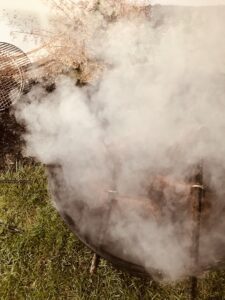 Next, it’s time to set up the smoker. If you’re using a wood-fired or propane smoker, make sure to fill it up with the appropriate fuel and light it according to the manufacturer’s instructions. If you’re using an electric smoker or pellet grill, simply plug it in and turn it on. Target a low temperature between 225F-275F.
Next, it’s time to set up the smoker. If you’re using a wood-fired or propane smoker, make sure to fill it up with the appropriate fuel and light it according to the manufacturer’s instructions. If you’re using an electric smoker or pellet grill, simply plug it in and turn it on. Target a low temperature between 225F-275F.
While your smoker is heating up, apply your dry rub. The dry rub helps to flavor the pork and give it a nice crust with great color when it’s cooked. Apply it to the surface of the pork shoulder or pork butt, making sure to coat it evenly. Rub the mixture into the meat using your hands—gloves are helpful. You should use enough rub that it evenly coats the entire outside surface of the meat, but that you can still see through to the meat.
Wood For Smoking
Once the smoker is heated up, it’s time to add the wood chips or chunks. Different types of wood can have a big impact on the flavor of the final product. Here are a few of the best woods to use for smoking pulled pork:
Oak: Oak is a dense and flavorful wood that is great for smoking a wide range of meats, including pulled pork. It has a strong, smoky flavor that pairs well with the rich, savory flavors of pork.
Maple: Maple is a sweet and subtle wood that is great for adding a touch of sweetness to pulled pork. It has a mild, slightly sweet flavor that pairs well with the natural sweetness of pork.
Apple: Apple is a fruity and sweet wood that is great for adding a touch of sweetness to pulled pork. It has a mild, slightly sweet flavor that pairs well with the natural sweetness of pork.
Cherry: Cherry is a fruity and sweet wood that is great for adding a touch of sweetness to pulled pork. It has a mild, slightly sweet flavor that pairs well with the natural sweetness of pork.
Pecan: Pecan is a nutty and sweet wood that is great for adding a touch of sweetness to pulled pork. It has a mild, slightly sweet flavor that pairs well with the natural sweetness of pork.
Experiment with different woods and see which ones you like best. Just be sure to use wood chips or wood chunks, as opposed to logs, as they will burn more evenly and provide a more consistent flavor.
Our recommendation is a combination of hickory, cherry, and pecan.
Step 3: Smoke the pork
Now it’s time to place the pork shoulder or butt into the smoker. The key to smoking pulled pork is to maintain a low and steady temperature. Too hot will cook too fast and your pork will be tough. Tool low and it will take unnecessarily long. Fluctuations in temperature can also cause the meat to toughen up. So be sure to adjust the heat as needed to keep it in the 225-275 degree Fahrenheit range as consistently as possible. If you want to apply a thin BBQ sauce like the vinegar-based recipe above, wait until you start seeing a crust forming, then apply about once per hour or two. Applying thicker or sweet/sugary sauces is not recommended until late in the cook.
Step 4: Monitor the temperature
As the pork smokes, it’s important to keep an eye on the internal temperature. The best way to do this is to use a meat thermometer. The magic number we’re looking for is an internal temperature of 203 degrees Fahrenheit. This will ensure that the pork is cooked to perfection and tender enough to easily pull apart.
Step 4B (Optional): The Texas Crutch
The Texas Crutch is a way of speeding up the cooking time of p
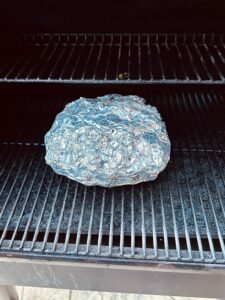
ulled pork, without sacrificing flavor or tenderness. After several hours of smoking, the meat is maxed out and has absorbed as much smoke flavor as you’re going to get and has formed a nice crust, but the internal juices are just getting flowing. When the internal temperature reaches 165 Fahrenheit, wrap it tightly in foil with some juice (vinegar based BBQ sauce, beer, meat broth, or even cola works) and place back on the smoker. This will usually take about 2 hours off the cook time for a pork butt or shoulder. If you want to apply your thicker/sweeter sauce, this is a good time to do so.
Step 5: Rest the Meat
Once the pork has reached the magic temperature of 203F, it’s done cooking, but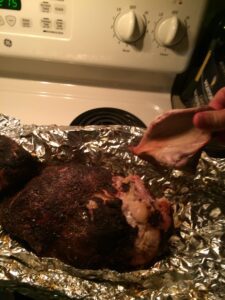 not ready for serving just yet. If you’re going to apply BBQ sauce, it’s time to apply your BBQ sauce. Give it about 15 minutes for the sauce to firm up. Next we want to give the pork some resting time to allow the temperatures to even out and the meat to relax. Double-wrap the shoulder in foil with some juice (vinegar based BBQ sauce, beer, meat broth, or even cola works) for a minimum of 15 minutes. For better results, an hour is optimal if you can maintain temperature. There are a few ways to do this. If you’re using a device that allows pretty good temperature control, you can put the pork back in at 180F. Another way is to place the foil wrapped shoulder in a picnic cooler with some towels loosely folded over to maintain the heat.
not ready for serving just yet. If you’re going to apply BBQ sauce, it’s time to apply your BBQ sauce. Give it about 15 minutes for the sauce to firm up. Next we want to give the pork some resting time to allow the temperatures to even out and the meat to relax. Double-wrap the shoulder in foil with some juice (vinegar based BBQ sauce, beer, meat broth, or even cola works) for a minimum of 15 minutes. For better results, an hour is optimal if you can maintain temperature. There are a few ways to do this. If you’re using a device that allows pretty good temperature control, you can put the pork back in at 180F. Another way is to place the foil wrapped shoulder in a picnic cooler with some towels loosely folded over to maintain the heat.
Step 6: Pull the pork
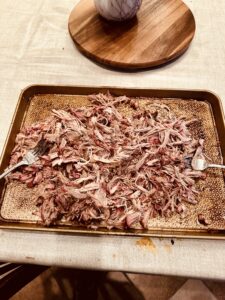 Once the pork shoulder or pork butt is fully cooked and rested, we’re ready to start pulling! Remove the foil, and save the juices in a cup or bowl. You can use a variety of tools to pull the pork, including a fork, tongs, specialty shredding forks or claws, or just using your hands—silicone gloves work great for this. Using a fork or a pair of tongs or whatever implement of destruction you choose, shred the pork into small pieces, pulling the meat apart in opposite directions. As you pull the pork, remove the bone and any large pieces of fat or gristle that you come across. Once the pork is fully pulled, slowly pour the juice you saved from foil wrap over the shredded meat.
Once the pork shoulder or pork butt is fully cooked and rested, we’re ready to start pulling! Remove the foil, and save the juices in a cup or bowl. You can use a variety of tools to pull the pork, including a fork, tongs, specialty shredding forks or claws, or just using your hands—silicone gloves work great for this. Using a fork or a pair of tongs or whatever implement of destruction you choose, shred the pork into small pieces, pulling the meat apart in opposite directions. As you pull the pork, remove the bone and any large pieces of fat or gristle that you come across. Once the pork is fully pulled, slowly pour the juice you saved from foil wrap over the shredded meat.
Step 7: Serve and enjoy!
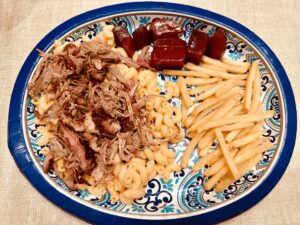 Once the pork is pulled, it’s ready to serve. You can serve it as is, or you can use it to make sandwiches, tacos, or any other dish you can dream up. You can freeze the leftovers for a quick and easy meal later on.
Once the pork is pulled, it’s ready to serve. You can serve it as is, or you can use it to make sandwiches, tacos, or any other dish you can dream up. You can freeze the leftovers for a quick and easy meal later on.
- Pulled pork sandwiches: Serve the pulled pork on a bun with coleslaw, pickles, and your favorite BBQ sauce.
- Pulled pork tacos: Use warm corn tortillas as the base, and top with pulled pork, diced onions, cilantro, and salsa.
- Pulled pork pizza: Use pulled pork as a topping for a BBQ pizza, along with red onion, cilantro, and a sprinkle of cheddar cheese.
- Pulled pork nachos: Top tortilla chips with pulled pork, cheese, jalapenos, and salsa for a delicious snack.
- Pulled pork egg rolls: wrap pulled pork, shredded carrots, and cabbage in wonton wrappers and deep-fry for a crispy treat.
- Pulled pork sliders: make mini sandwiches with pulled pork, sliced pickles, and a honey mustard sauce.
- Pulled pork mac and cheese: Mix pulled pork with elbow macaroni, cheese sauce and top with shredded cheese.
- Pulled pork quesadillas: Put pulled pork, diced onion, and shredded cheese in between two tortillas, then grill until the cheese is melted.
Slammin' Side Dishes
Pulled pork is incredibly versatile as the main dish and pairs well with a wide range of sides:
- Coleslaw: A classic side dish for pulled pork, coleslaw is made with shredded cabbage and carrots tossed in a mayonnaise-based dressing. It adds a cool and refreshing contrast to the rich and savory flavors of pulled pork.
- Baked beans: Baked beans are a classic BBQ side dish that pairs well with pulled pork. They add a sweet and savory flavor to the meal, and their hearty texture is a perfect match for the tender pulled pork.
- Cornbread: Cornbread is a delicious and slightly sweet bread that pairs well with pulled pork. It adds a nice contrast to the savory flavors of the pork, and it’s a great way to sop up any leftover BBQ sauce. A melted butter and honey drizzle takes this side next-level!
- Mac and cheese: Mac and cheese is a creamy and comforting side dish that pairs well with pulled pork. It adds a rich and creamy flavor to the meal, and its cheesy goodness is always a hit with kids and adults alike.
- Mashed potatoes: Mashed potatoes are a classic side dish that pairs well with pulled pork. They add a creamy and comforting flavor to the meal, and their soft texture is a great match for the tender pulled pork.
- Street corn: Grilled corn is a delicious and slightly sweet side dish that pairs well with pulled pork. It adds a smoky and slightly sweet flavor to the meal, and its crunchy texture is a great contrast to the tender pulled pork.
- Biscuits: Biscuits are a classic side dish that pairs well with pulled pork. They add a flaky and buttery flavor to the meal, and they’re a great way to soak up any leftover BBQ sauce.
- Roasted vegetables: Roasted vegetables are a delicious and healthy side dish that pairs well with pulled pork. They add a crisp and savory flavor to the meal, and their tender texture is a great contrast to the tender pulled pork.
- Fried okra: Fried okra is a southern classic that pairs well with pulled pork. It adds a crispy and savory flavor to the meal, and its crunchy texture is a great contrast to the tender pulled pork.
- Potato salad: Potato salad is a creamy and flavorful side dish that pairs well with pulled pork. It adds a cool and refreshing flavor to the meal, and its creamy texture is a great contrast to the tender pulled pork.
And that’s it! With a little bit of patience and some attention to detail, you’ll be able to smoke the perfect pulled pork every time. Just be sure to keep an eye on the temperature and have plenty of wood chips or chunks on hand, and you’ll be well on your way to BBQ greatness. Happy smoking!
BBQ Sauce Recipes
Vinegar-Based BBQ Sauce
Vinegar-based BBQ sauce is a sharp and tangy sauce that is especially popular in the eastern part of North Carolina. It pairs well with smoked pulled pork and adds a unique twist to the classic BBQ flavor. Here’s how to make your own vinegar-based BBQ sauce for pulled pork:
Ingredients:
1 cup apple cider vinegar
1/2 cup brown sugar
2 tablespoons Worcestershire sauce
1 tablespoon paprika
1 tablespoon garlic powder
1 tablespoon onion powder
1 teaspoon black pepper
1 teaspoon cumin
1 teaspoon salt
Instructions:
In a small saucepan, combine all of the ingredients.
Bring the mixture to a boil over medium heat, then reduce the heat to low and simmer for 10-15 minutes, stirring occasionally, until the sauce has thickened.
Remove the sauce from the heat and let it cool.
Once the sauce has cooled, you can use it to coat your smoked pulled pork. Simply brush the sauce onto the pork, or mix it in with the pulled pork before serving.
If you have any leftover sauce, you can store it in the fridge in an airtight container for up to a week.
And that’s it! This simple vinegar-based BBQ sauce is a delicious and unique way to add flavor to your smoked pulled pork. Experiment with different levels of sweetness to find the perfect balance for your taste preferences. Enjoy!
Tomato-Based BBQ Sauce
Tomato-based BBQ sauce is a classic choice for smoked pulled pork, as it has a sweet and tangy flavor that pairs well with the smoky and savory flavors of the pork. Here’s how to make your own tomato-based BBQ sauce for pulled pork:
Ingredients:
1 cup ketchup
1/2 cup apple cider vinegar
1/4 cup brown sugar
2 tablespoons Worcestershire sauce
1 tablespoon paprika
1 tablespoon garlic powder
1 tablespoon onion powder
1 teaspoon black pepper
1 teaspoon cumin
1 teaspoon mustard powder
1/2 teaspoon salt
Instructions:
In a small saucepan, combine all of the ingredients.
Bring the mixture to a boil over medium heat, then reduce the heat to low and simmer for 10-15 minutes, stirring occasionally, until the sauce has thickened.
Remove the sauce from the heat and let it cool.
Once the sauce has cooled, you can use it to coat your smoked pulled pork. Simply brush the sauce onto the pork, or mix it in with the pulled pork before serving.
If you have any leftover sauce, you can store it in the fridge in an airtight container for up to a week.
And that’s it! This simple tomato-based BBQ sauce is the perfect complement to smoked pulled pork, and it’s easy to make at home with just a few simple ingredients. Enjoy!
Mustard-Based BBQ Sauce
Mustard-based BBQ sauce is a tangy and slightly spicy sauce that is especially popular in the southeastern United States. It pairs well with smoked pulled pork and adds a unique twist to the classic BBQ flavor. Here’s how to make your own mustard-based BBQ sauce for pulled pork:
Ingredients:
1 cup yellow mustard
1/2 cup apple cider vinegar
1/4 cup brown sugar
2 tablespoons Worcestershire sauce
1 tablespoon paprika
1 tablespoon garlic powder
1 tablespoon onion powder
1 teaspoon black pepper
1 teaspoon cumin
1 teaspoon salt
Instructions:
In a small saucepan, combine all of the ingredients.
Bring the mixture to a boil over medium heat, then reduce the heat to low and simmer for 10-15 minutes, stirring occasionally, until the sauce has thickened.
Remove the sauce from the heat and let it cool.
Once the sauce has cooled, you can use it to coat your smoked pulled pork. Simply brush the sauce onto the pork, or mix it in with the pulled pork before serving.
If you have any leftover sauce, you can store it in the fridge in an airtight container for up to a week.
And that’s it! This simple mustard-based BBQ sauce is a delicious and unique way to add flavor to your smoked pulled pork. Experiment with different levels of spiciness and sweetness to find the perfect balance for your taste preferences. Enjoy!
Honey BBQ sauce
Honey BBQ sauce
Honey BBQ sauce is a sweet and slightly tangy sauce that pairs well with smoked pulled pork. It adds a unique twist to the classic BBQ flavor and is easy to make at home. Here’s how to make your own honey BBQ sauce for pulled pork:
Ingredients:
1 cup ketchup
1/2 cup honey
1/4 cup apple cider vinegar
2 tablespoons Worcestershire sauce
1 tablespoon paprika
1 tablespoon garlic powder
1 tablespoon onion powder
1 teaspoon black pepper
1 teaspoon cumin
1 teaspoon mustard powder
1/2 teaspoon salt
Instructions:
In a small saucepan, combine all of the ingredients.
Bring the mixture to a boil over medium heat, then reduce the heat to low and simmer for 10-15 minutes, stirring occasionally, until the sauce has thickened.
Remove the sauce from the heat and let it cool.
Once the sauce has cooled, you can use it to coat your smoked pulled pork. Simply brush the sauce onto the pork, or mix it in with the pulled pork before serving.
If you have any leftover sauce, you can store it in the fridge in an airtight container for up to a week.
And that’s it! This simple honey BBQ sauce is a delicious and unique way to add flavor to your smoked pulled pork. Experiment with different levels of sweetness to find the perfect balance for your taste preferences. Enjoy!
Hot BBQ Sauce
Hot BBQ sauce is a spicy and flavorful sauce that pairs well with smoked pulled pork for those who like a little extra heat in their BBQ. Here’s how to make your own hot BBQ sauce for pulled pork:
Ingredients:
1 cup ketchup
1/2 cup apple cider vinegar
1/4 cup brown sugar
2 tablespoons Worcestershire sauce
1 tablespoon paprika
1 tablespoon garlic powder
1 tablespoon onion powder
1 teaspoon black pepper
1 teaspoon cumin
1 teaspoon mustard powder
1/2 teaspoon salt
1-2 tablespoons hot sauce (such as Sriracha or Tabasco), or to taste
Instructions:
In a small saucepan, combine all of the ingredients.
Bring the mixture to a boil over medium heat, then reduce the heat to low and simmer for 10-15 minutes, stirring occasionally, until the sauce has thickened.
Remove the sauce from the heat and let it cool.
Once the sauce has cooled, you can use it to coat your smoked pulled pork. Simply brush the sauce onto the pork, or mix it in with the pulled pork before serving.
If you have any leftover sauce, you can store it in the fridge in an airtight container for up to a week.
And that’s it! This simple hot BBQ sauce is a delicious and spicy way to add flavor to your smoked pulled pork. Experiment with different levels of heat to find the perfect balance for your taste preferences. Enjoy!















2 Responses
Nice post. I learn something more challenging on different blogs everyday. It will always be stimulating to read content from other writers and practice a little something from their store. I’d prefer to use some with the content on my blog whether you don’t mind. Natually I’ll give you a link on your web blog. Thanks for sharing.
An interesting discussion is definitely worth comment. I do believe that you should publish more about this subject, it may not be a taboo matter but typically people dont discuss these subjects. To the next! Many thanks!!